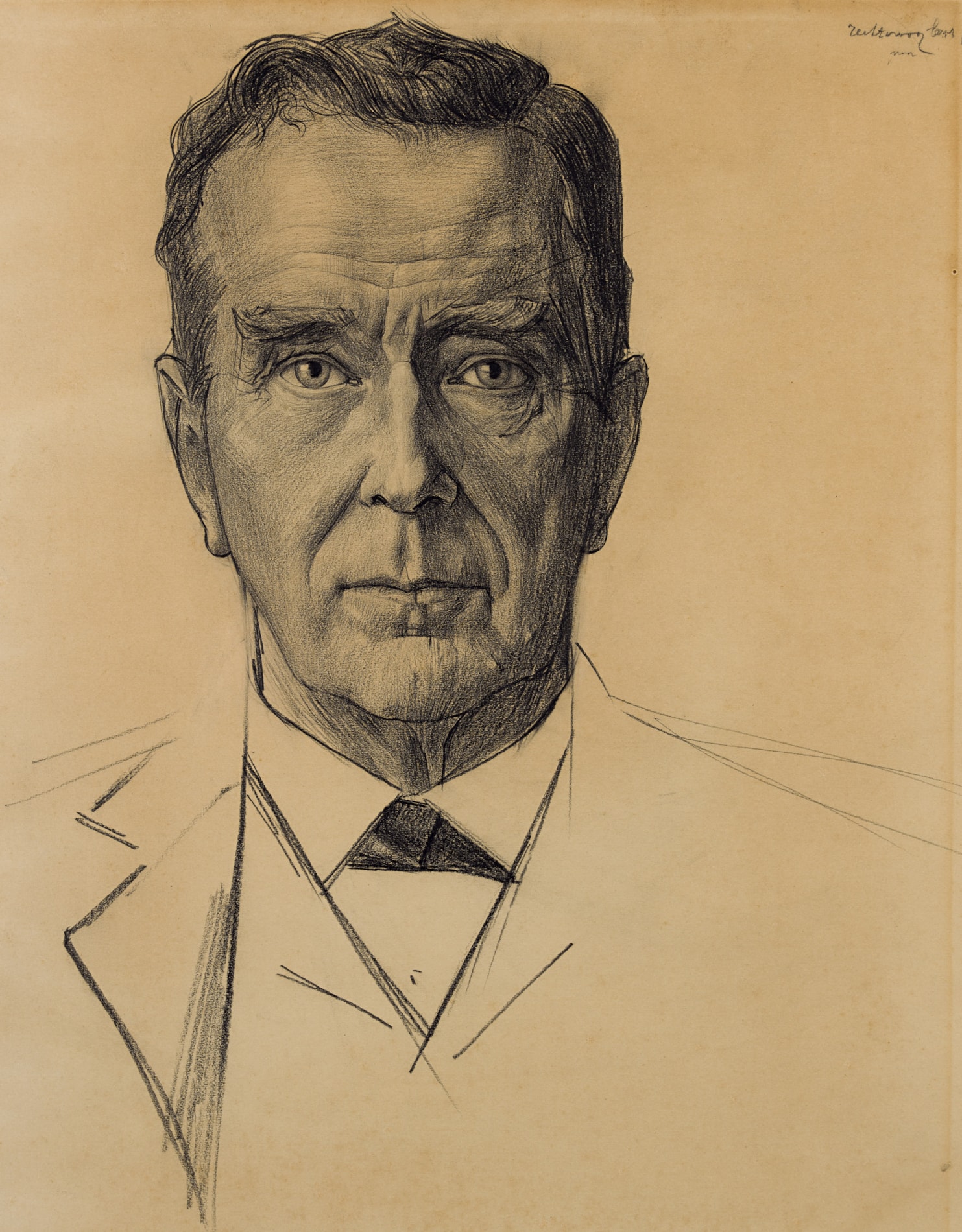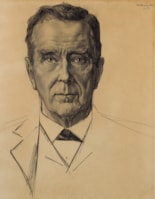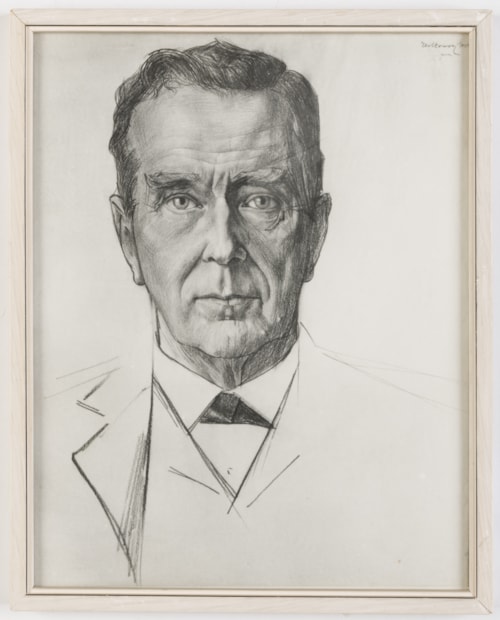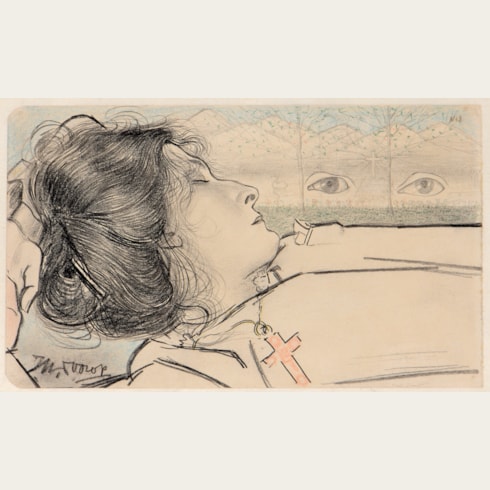Jan TOOROP
(Poerworedjo 1858 - The Hague 1928)
Portrait of the Rev. Dr. Jan Heldring
Charcoal and pencil.
Signed JthToorop at the upper right.
Inscribed Jan Heldring, with other illegible inscriptions and dimensions in the right margin.
The drystamp of the stationers Boekhandel A. J. Nuss, Amsterdam (not in Lugt) stamped at the lower right.
Inscribed ‘Portrait of my grandfather / Revd. Dr. Jan Lodewijk Heldring / of Amsterdam. Charcoal drawing / by Jan Toorop. / Ranulph Bye / Refitted and matted January 1982’ on a typewritten label pasted onto the old backing paper.
455 x 360 mm. (17 7/8 x 14 1/8 in.) [image]
485 x 406 mm. (19 1/8 x 16 in.) [sheet]
Signed JthToorop at the upper right.
Inscribed Jan Heldring, with other illegible inscriptions and dimensions in the right margin.
The drystamp of the stationers Boekhandel A. J. Nuss, Amsterdam (not in Lugt) stamped at the lower right.
Inscribed ‘Portrait of my grandfather / Revd. Dr. Jan Lodewijk Heldring / of Amsterdam. Charcoal drawing / by Jan Toorop. / Ranulph Bye / Refitted and matted January 1982’ on a typewritten label pasted onto the old backing paper.
455 x 360 mm. (17 7/8 x 14 1/8 in.) [image]
485 x 406 mm. (19 1/8 x 16 in.) [sheet]
Beginning in the early years of the 20th century, at around the time of his conversion to Catholicism, Toorop painted and drew a number of striking portraits of priests and clergymen. He was particularly active in this regard during the years between 1910 and 1913, when he produced several arresting portraits of Jesuits at the Canisius College in Nijmegen. (It should be noted, however, that during the years in The Hague which found him most active as a painter of religious subjects for churches, he painted very few portraits of clerics.) Toorop’s avowed Catholicism did not, however, prevent him from making portraits of Protestant clergymen, of which the present sheet is a particularly fine example.
This large pencil portrait of Dr. Jan Lodewijk Heldring (1852-1923), a pastor and member of the Dutch Reformed Church in Amsterdam, is typical of Toorop’s portraiture in its precise and direct treatment of the head of the sitter. In many of his large-scale portrait drawings, the artist preferred to depict his subjects full face and head-on, seemingly in direct confrontation with the viewer. This large drawing has remained in the sitter’s family until recently, having passed by descent to Heldring’s grandson, Ranulph Bye (1916-2003), an American artist and writer.
A photograph of Jan Heldring as a younger man is contained in an album of photographs of members of the Heldring family and other Dutch families, in the iconographic collection of the RKD Netherlands Institute for Art History in The Hague.
This large pencil portrait of Dr. Jan Lodewijk Heldring (1852-1923), a pastor and member of the Dutch Reformed Church in Amsterdam, is typical of Toorop’s portraiture in its precise and direct treatment of the head of the sitter. In many of his large-scale portrait drawings, the artist preferred to depict his subjects full face and head-on, seemingly in direct confrontation with the viewer. This large drawing has remained in the sitter’s family until recently, having passed by descent to Heldring’s grandson, Ranulph Bye (1916-2003), an American artist and writer.
A photograph of Jan Heldring as a younger man is contained in an album of photographs of members of the Heldring family and other Dutch families, in the iconographic collection of the RKD Netherlands Institute for Art History in The Hague.
Born and raised in Java in the Dutch East Indies, Jan (Johannes) Theodoor Toorop settled in Holland in 1872, at the age of fourteen. He studied in Delft, Amsterdam and Brussels, where he lived between 1882 and 1886. There he met James Ensor, with whom he travelled to Paris. In 1884 he became a member of the Belgian artistic and literary group Les XX (Les Vingt), formed the previous year and centred on Ensor, and proceeded to exhibit with the group for several years thereafter. His early work saw the artist working in a variety of styles, sometimes concurrently, ranging from Realism to Impressionism and Neo-Impressionism; the latter in particular was used for a series of splendid and brightly-coloured pointillist landscapes, as well as some portraits and genre scenes, until 1907. Toorop had his first exhibition in 1885, and the same year visited England, where he met James McNeill Whistler and discovered the work of the Pre-Raphaelite painters and William Morris. After his marriage to an Englishwoman in 1886, Toorop divided his time between England, Brussels and The Hague, as well as the small artist’s colony in the seaside resort of Katwijk aan Zee in Holland, where he lived from 1890.
In the early 1890s, influenced by the writings of Emile Verhaeren and Maurice Maeterlinck, Toorop began to work in a Symbolist vein, producing a number of large, complex and highly finished drawings which are among his most famous works. Perhaps the best known of these impressive Symbolist drawings - densely drawn and iconographically mysterious works in which the influence of Aubrey Beardsley and the Pre-Raphaelite painters is evident - are O Grave, Where is Thy Victory? of 1892, today in the Rijksmuseum in Amsterdam, and The Three Brides of 1892-1893, in the Kröller-Müller Museum in Otterlo. Toorop’s work began to be exhibited abroad, notably at the first Salon de la Rose + Croix in Paris in 1892 and at the Vienna Secession in 1900 and 1902, where it was a particular influence on the work of a slightly younger artist in Vienna, Gustav Klimt. By the turn of the century Toorop was established among the leading avant-garde artists in Holland, with his work influential in the development of the International Art Nouveau style.
Among Toorop’s first large-scale public commissions were three ceramic murals for the Beurs van Berlage, the stock exchange building in Amsterdam, completed in 1903. In 1905 Toorop, together with his daughter Charley, converted to Roman Catholicism, which would have a profound impact on his work for the remainder of his career. He began to produce a large number of often overtly religious works, many of which were reproduced as prints or in facsimile and displayed in private homes throughout the Low Countries. Among the few official commissions he received from the Catholic Church in Holland were designs for stained glass windows in the Sint Jozefskerk in Nijmegen, executed in 1913, as well as a series of paintings of the Stations of the Cross for the church of St. Bernulphus in Oosterbeek, begun in 1916 and completed in 1919. By this time he was in poor health, however, and by 1920 was largely confined to a wheelchair, with his left leg paralyzed. Nevertheless, he continued to work effectively, producing numerous drawings and prints.
As a draughtsman, Jan Toorop was extremely accomplished, both in his use of a range of materials and also in the effects he was able to achieve with them. As has been noted of his monumental drawings of the early 1890s in particular, ‘His Symbolist work, chiefly executed in pencil, black crayon and coloured chalk, was dominated by powerful draughtsmanship.’ Toorop produced designs for posters, book illustrations and covers, and postage stamps. He also made around fifty prints, mainly drypoints, for which he perferred to use zinc plates instead of the harder copper plates, which meant that only a few impressions of each print could be made. Toorop was also a superb portraitist, and produced a large number of drawn and painted portraits of family, friends and fellow artists, as well as many portraits – usually in the form of highly finished drawings - of some of the leading Dutch writers, poets, clergymen, politicians, lawyers, musicians, composers and intellectuals of his day. Indeed, Toorop may justifiably be claimed as one of the finest Dutch portraitists of the early 20th century.
Provenance
By descent to the sitter’s grandson, Ranulph Bye, Holicong, Pennsylvania
Private collection, New Jersey.
Private collection, New Jersey.
Literature
Peter van der Coelen, ‘Een leven lang ‘smoelletjes maken’: Jan Toorop en de praktijk van het portretteren’, in Peter van der Coelen and Karin van Lieverloo, Jan Toorop Portrettist, exhibition catalogue, Nijmegen, 2003, p.29.








